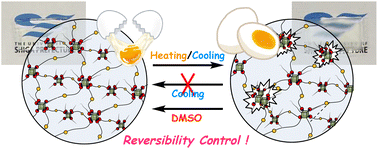Control over the reversibility of property changes of a stimuli-responsive polymer hydrogel such as transient fixation and on-demand recovery is a key challenge in realizing a sophisticated function as observed in natural soft tissues. Inspired by the denaturation process of proteins, we focused on incorporation of a highly hydrophobic component into a thermoresponsive hydrogel to induce internal structural fixation by hydrophobic aggregation upon thermoresponsive macroscopic shrinking of a gel network. A polyhedral oligomeric silsesquioxane (POSS) compound with 8 ammonium cation groups was employed as a crosslinker for gel synthesis through end-crosslinking of telechelic poly(N-isopropylacrylamide) (PNIPAAm) with an activated ester terminus, which was prepared by reversible addition–fragmentation chain-transfer (RAFT) polymerization. POSS-crosslinked PNIPAAm gels were obtained with good reproducibility under the reaction conditions in the presence of a large amount of a base. The product gels exhibited reversible swelling/deswelling in water against temperature change; however, their appearance did not return to the original transparency once the gel was heated in water. This behavior contrasts sharply with the reversible change in appearance with a normal PNIPAAm gel. The “irreversible” change in turbidity was likely to result from the aggregation of the POSS moieties induced by macroscopic volume shrinking of the POSS-containing PNIPAAm gels. This internal structural change also led to an appreciable change in mechanical properties: an increase in Young's modulus and elongation. In addition, the turbid POSS-crosslinked gels after a heating/cooling cycle returned to almost transparent ones by immersion in a highly polar solvent such as dimethylsulfoxide.
